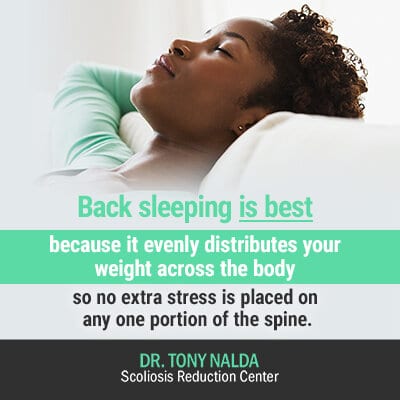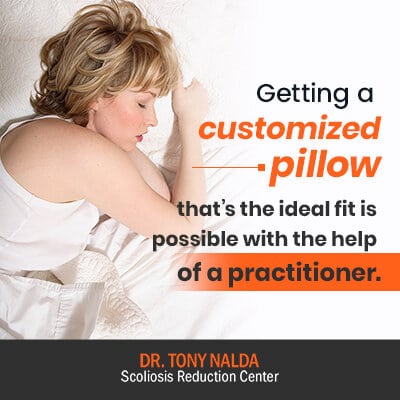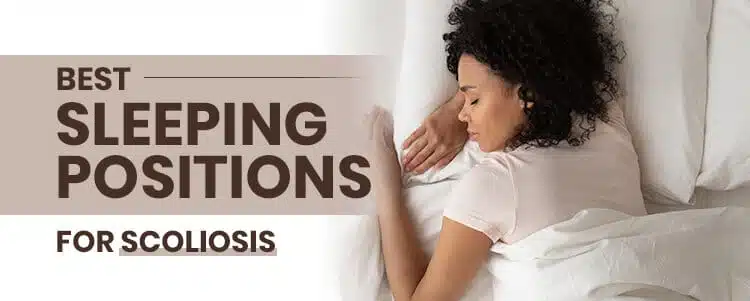When it comes to the best sleeping positions for someone living with scoliosis, they are not much different than the best sleeping positions for someone not living with the condition. The best positions are those that promote spine health through proper alignment and provide some relief from scoliosis-related discomfort. There are, however, no sleeping positions capable of producing a structural change and reducing a person’s scoliosis.
While exploring the best sleeping positions for scoliosis, you will see that they are the same for both people with and without scoliosis. However, some people assume that sleeping a certain way can help gravity impact a person’s scoliosis structurally, and this is not the case. Let’s first take a look at the order of sleeping positions for someone living with scoliosis, from best to worst.
4 Key Takeaways
- Optimal Sleeping Positions for Scoliosis: The best sleeping positions for individuals with scoliosis are the same as for those without the condition, focusing on promoting spinal health and alignment. Back sleeping is ideal, followed by side sleeping with proper support, while stomach sleeping is the least favorable due to its potential to exacerbate spinal misalignment.
- No Structural Change from Sleeping Position: Despite some beliefs, no sleeping position can structurally alter or improve scoliosis. Effective treatment must address the condition on a structural level, which sleeping positions alone cannot achieve.
- Customized Pillows for Better Support: Custom-fitted pillows can significantly enhance sleeping comfort and spinal alignment for individuals with scoliosis, underscoring the importance of personalizing sleep support to fit one’s body size, shape, and specific condition.
- Importance of Restorative Sleep in Treatment: Quality sleep is crucial for overall health and well-being, especially for individuals with scoliosis undergoing treatment. A well-rested body responds better to treatment, highlighting the need for focusing on optimal sleeping positions and support to improve treatment outcomes and daily functioning.
Sleeping Positions that Promote Spinal Alignment
The best sleeping positions for someone with scoliosis are those that promote a healthy spine through spinal alignment and provide relief where needed; while this can also be said for people who aren’t living with scoliosis, it’s especially helpful for those living with an abnormal sideways curvature of the spine.
When a person develops scoliosis, their spine is no longer in alignment. This means the spine’s natural healthy curves have been lost and replaced by unnatural ones.
When treating scoliosis, the goal is to reduce the patient’s abnormal curvature as much as possible to restore the spine’s healthy curves and improve its overall biomechanics.
Unfortunately, as scoliosis is a progressive condition with no known cure, the spine will never be perfectly aligned again. It’s the spinal misalignment that can cause compression of the spine and its surrounding muscles and nerves; this can cause pain, especially in severe cases, or cases of adult scoliosis.
Finding a sleeping position that promotes proper spinal alignment can also help provide some relief from scoliosis-related pain and discomfort.
Back Sleeping

The best sleeping position for someone living with an abnormal spinal curvature is flat on the back; this is also the best sleeping position for anyone. This position supports the normal and natural curvatures of the spine, such as the cervical curve (upper back) and lumbar lordosis (inward curve of the lower back).
Back sleeping is best because it evenly distributes your weight across the body so no extra stress is placed on any one portion of the spine.
Side Sleeping
The next best position is to sleep on the side with a pillow that supports the head in a neutral alignment to the torso, and the torso in a neutral alignment to the pelvis.
If you think of a snowman, this is the alignment you want to aim for while sleeping: a neutral head centered with the torso, and the torso centered with the pelvis.
Even though there could be a spinal curvature between the snowballs, the snowman still lines up while in a good sleeping position.
Stomach Sleeping
Stomach sleeping is the worst position for someone with scoliosis because it doesn’t promote proper spinal alignment and support. It’s also the worst sleeping position for people in general.
Sleeping on your stomach arches the back, putting the upper back and neck (cervical curve) in an unnatural position; this puts extra stress on the spine that’s already experiencing adverse spinal tension due to scoliosis.
Can Sleeping Position Improve Scoliosis?
As scoliosis progresses, especially if left untreated, the spine becomes more and more rigid. This becomes a structural deformity, and any effective treatment plan has to address the condition on a structural level.
While sleeping positions can help promote spinal alignment and ease discomfort, there is no position that can actually help a person’s scoliosis on a structural level; only active treatment can do that.
Let’s say you have a left lumbar curve and you’re thinking if you sleep on your right side, that gravity will push the curve flatter: that’s not going to happen. Sleeping position has neither the duration, nor the power that would be required to achieve that kind of a structural change.
The only way to achieve the kind of structural change needed to reduce a person’s scoliosis is by engaging in active treatment. Here at the Scoliosis Reduction Center®, we do just that by customizing a treatment plan that integrates four main treatment tools at varying proportions: scoliosis-specific exercise, bracing, therapy, and chiropractic.
What you want to achieve with your sleeping position is to support the general health of your spine, and in order of best to worst sleeping position is on the back, sides, and stomach-sleeping.
Customized Pillows for Scoliosis
Scoliosis can take many forms and develops across a wide spectrum of mild, moderate, or severe. What this means is that any effective treatment plan has to be 100-percent customized to each and every patient’s condition type, location, severity, symptoms, age and fitness level.

Just as treatment has to be customized to be effective, a person with scoliosis wanting to find the best sleeping position should be using a fitted pillow that’s designed for their size.
The problem is most pillows are one size, fits all, but how is that possible? A patient that’s 6-feet tall isn’t going to need the same size pillow as someone who is 4-feet tall.
The idea is that you should have a pillow that’s fitted to your body size, shoulders, back, and pelvis. That’s something I do for my patients: measure them and find a pillow that supports their spine properly.
Getting a customized pillow that’s the ideal fit is possible with the help of a practitioner. We can get you fitted and find one that will best support your spine’s health and alignment.
Conclusion
Getting the best possible night’s sleep has numerous health-and-wellness benefits. Sleep helps us rest our bodies and minds so we’re ready to face the next day. Anyone who has ever struggled with insomnia knows exactly how disruptive sleeplessness can be when it comes to fulfilling one’s daily responsibilities, routines, and trying to be productive.
For someone living with a progressive condition like scoliosis, getting a restorative sleep can be all the more important and difficult. This is especially true in cases of adult scoliosis that can be painful, or in patients who haven’t had treatment and their condition has been left to progress.
Untreated scoliosis can cause associated complications such as lung impairment, digestive issues, and cardiac problems. Any one of these issues, including back and radiating pain, has the potential to disrupt sleep.
When it comes to undergoing the rigors of scoliosis treatment, a well-rested body is going to respond much better, increasing the likelihood of a positive prognosis.
When it comes to finding the best sleeping position for scoliosis, it’s on the back, then the sides, and the worst position is on the stomach. These are the same for someone without scoliosis, but for someone living with a misaligned spine, focusing on healthier sleeping positions that promote spinal alignment is even more important.
Here at the Scoliosis Reduction Center®, we treat the whole patient. Our treatment plans take into account any symptoms or scoliosis-related complications our patients are experiencing.
Sleep is important, so we take it seriously and guide our patients in finding the best sleeping position and a fitted supportive pillow.





